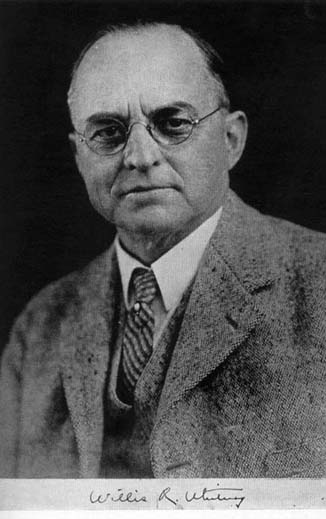|
|
|
This article was written by fellow lamp engineer and collector Edward J. Covington, and originally appeared on his own website of biographical sketches of persons involved in the lamp industry. Following his passing in February 2017, and with kind permission of his family, Ed's words have been preserved here in the hope of maintaining access to his writings for the benefit of subsequent generations.
|

Willis Whitney1 |
Biography
The GEM (General Electric Metallized) filament was developed by Willis R. Whitney, who headed the General Electric research efforts for many years 1,2. The story is best told in Whitney's own words 1:
"Carbon had been electrically such a wonder element, that one of the research chemists devoted himself exclusively to it for many years. It had long served for brushes on motors, for arc lamp electrodes and for incandescent filaments. These were then composed of two forms of carbon. A core or base as it was called, consisted of carbon made from dissolved cotton and this had a coat or cover of graphite which gave a smooth and shiny surface, but also served to even up irregularities in the original base. The base carbon at the time contained traces of unreduced mineral oxides, ash, so-called, from the cotton. Seeking to improve the lamps we sought to eliminate that ash. In making the filaments they had been heated only as high as gas muffles could reach. The remaining oxides might be spoiling the lamps during their burning life. Even that ash when heated in the lamps could slowly yield gaseaous oxides of carbon. These oxides could then react to transport carbon from the filament to the colder glass and so blacken it. And the glass did blacken with the burning life of a lamp. The reaction C plus CO2 equals two CO reverses with changed temperature and that explained the carbon deposit on the glass. So it seemed desirable to preheat the bases to some very high temperature before their use in lamps. There was no ash in the graphite, as this was put on by heating the bases in very dilute benzene vapor.
"We began preheating bases in an electrically heated carbon tube furnace which was protected from rapid evaporation by carbon powder covering it completely. The ends or terminals were water-cooled. This furnace could be run up in temperature to about 3500 C where carbon readily vaporizes.
"We started using the factory-made carbon bases, but one particular shipment consisted, by mistake, of the graphite-coated or finished filaments. We put these through our new furnace-treatment and returned them to the factory. They produced lamps which blackened much less than usual. So the engineer of the factory became interested. We had already planned to heat thus all base filaments and add their graphite coat later, but this first accident gave us the confirmation of our guiding theory. These particular filaments in spite of not blackening the glass, were all covered with little blisters, and each blister had a tiny hole in it. Gases from the high temperature action had blown bubbles in the softened graphite coat so as to escape. The furnace- temperature was much higher than the filaments would ever be heated in the finished lamps. Base filaments heated in the furnace before being coated with graphite let the gases escape without affecting the carbon surface. They showed no roughness nor blisters. Then later, the graphite coat was put on and the new combination was reheated at the high temperature. This time the graphite coat remained without blisters, but had sintered or melted into a good smooth covering. Incidentally it was found that this new, sintered coat could be taken off (stripped) from its base filament, with care, thus giving us a very fine thin tube of the new graphite. This had a positive coefficient of resistance such as have the pure metals. So we called the new filaments 'metallized.' The temperature coefficient of former filaments had been negative. Our new lamp still looked like the old ones, but was 25% more efficient and we were proud of it. But the later work on metallic filaments soon made much better lamps possible."
References
- "Willis Rodney Whitney - Pioneer of Industrial Research", John T. Broderick, Fort Orange Press Inc., Albany, New York, 1945, pp.309-310.
- "Willis R. Whitney, General Electric, and the Origins of U. S. Industrial Research", George Wise, Columbia University Press, New York, 1985.
|
|
|
|
|
|
|